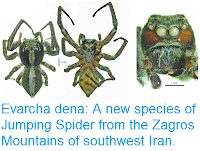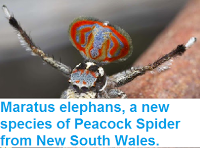Jumping Spiders, Salticidae, are the largest family of Spiders, with
about 5800 described species in 600 genera, roughly 13% of all described
species. They are noted for their exceptional vision, possibly the best
of any Arthropods, which is used in hunting, with these Spiders being
active hunters that stalk their prey before catching it with a final
leap, as well as in mating, with many species having evolved elaborate
courtship rituals.
In a paper published in the journal Peer J on 25 July 2017, Francisco Riquelme of the Laboratorio de Sistemática Molecular at the Universidad Autónoma del Estado de Morelos, and Miguel Menéndez-Acuña of the Centro de Investigación en Biodiversidad y Conservación, also at the Universidad Autónoma del Estado de Morelos, describe a new species of Jumping Spider from a peace of Miocene amber from Chiapas State in Mexico.
The ambers of Chiapas State,
Mexico, were laid down in the Miocene (and possibly Oligocene) in shallow
marine environments. The amber is thought to be derived from resin secreted
from a Leguminous tree of the genus Hymenaea,
which lived in mangrove forests along the Caribbean shoreline. This amber is
almost identical to amber produced in similar mangrove forests during the
Miocene in the Dominican Republic and to a lesser extent other parts of the
Caribbean, and a thriving, and sometimes illegal, trade in these fossils,
combined with poor recording by commercial fossil collectors (particularly
those acting illegally) means that fossils in Caribbean amber derived from
private collections can be hard to connect to their point of origin.
The new species is placed in the extant genus Maevia, which contains a number of extant species from North America, and possibly South America and Australasia, but no previously described fossil species, and given the specific name eureka, refering to the 'eureka moment' that occured when the specimen was found, it having been dug out by habd during the excavation of a latrine for use during fieldwork. The species is described from a single female specimen, 3.6 mm in length and pale brown in colour, with white markings, preserved in a piece of almost clear amber.
Maevia eureka. Amber inclusion as seen in raw condition using regular light. (A) Dorsal view. (B) Ventral. Scale bar 2 mm. Riquelme & Menéndez-Acuña (2017).
See also...
Follow Sciency Thoughts on
Facebook.







